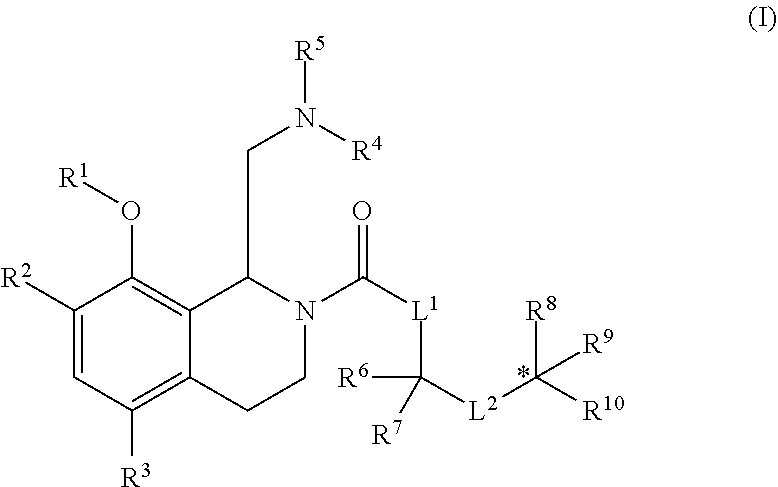Therapeutic compounds
a technology of therapeutic compounds and compounds, applied in the field of therapeutic compounds, can solve the problems of high morbidity and mortality rate, inability to prevent oxidative stress and inflammation in the ischemic brain, and misshapen red blood cells prone to ruptur
- Summary
- Abstract
- Description
- Claims
- Application Information
AI Technical Summary
Benefits of technology
Problems solved by technology
Method used
Image
Examples
example 1
(1S,2R)-2-((S)-1-((1,3-Dioxoisoindolin-2-yl)methyl)-8-(2-(5-methylisoxazole-3-carboxamido)ethoxy)-1,2,3,4-tetrahydroisoquinoline-2-carbonyl)cyclohexanecarboxylic acid
[0928]
[0929]Step a. To a stirred suspension of Intermediate 11 (0.45 g, 1.1 mmol) and caesium carbonate (1.44 g, 4.4 mmol) in DMF (6 mL) at rt was added N-(2-chloroethyl)-dibenzylamine hydrochloride (0.46 g, 1.5 mmol, CAS: 55-43-6) and the reaction was heated 100° C. for 18 h. The reaction mixture was concentrated in vacuo, diluted with water (25 mL) and extracted with DCM (25 mL). The organic layer was washed with further water (50 mL), dried over Na2SO4 and concentrated in vacuo to give tert-butyl (S)-8-(2-(dibenzylamino)ethoxy)-1-((1,3-dioxoisoindolin-2-yl)methyl)-3,4-dihydroisoquinoline-2(1H)-carboxylate (1.10 g, assumed quantitative). 1H NMR (400 MHz, DMSO-d6, rotamers observed, both reported) δ 7.98-7.75 (m, 4H), 7.44-7.03 (m, 11H), 6.83-6.72 (m, 2H), 5.54 (dd, 0.3H), 5.45 (dd, 0.7H), 4.42-3.90 (m, 4H), 3.81-3.64 ...
example 2
(1S,2R)-2-((S)-8-(2-(Benzo[d]oxazole-2-carboxamido)ethoxy)-1-((1,3-dioxoisoindolin-2-yl)methyl)-1,2,3,4-tetrahydroisoquinoline-2-carbonyl)cyclohexane-1-carboxylic acid
[0935]
[0936]Step a. Benzyl (1S,2R)-2-((S)-1-((1,3-dioxoisoindolin-2-yl)methyl)-8-hydroxy-1,2,3,4-tetrahydroisoquinoline-2-carbonyl)cyclohexane-1-carboxylate (370 mg, 59%) was prepared from Intermediate 10 (350 mg, 1.14 mmol) and Intermediate 26 (351 mg, 1.25 mmol) using a procedure similar to that described for Example 1, step e. LCMS (Method 4a): 2.86 min, 553.4 [M+H]+. 1H NMR (400 MHz, DMSO-d6) 9.86 (br s, 1H), 7.86-7.79 (m, 4H), 7.19-7.00 (m, 5H), 6.73 (d, 1H), 6.60 (d, 1H), 5.98 (dd, 1H), 4.77 (q, 2H), 4.22 (dd, 1H), 3.80 (d, 1H), 3.75-3.60 (m, 2H), 3.29-3.24 (m, 1H), 2.73-2.69 (m, 1H), 2.40 (dt, 1H), 1.84 (q, 1H), 1.68-1.60 (m, 1H), 1.50 (d, 1H), 1.36-1.23 (m, 3H), 1.00-0.76 (m, 3H), 0.15 (q, 1H).
[0937]Step b. Benzyl (1S,2R)-2-((S)-8-(2-((tert-butoxycarbonyl)amino)ethoxy)-1-((1,3-dioxoisoindolin-2-yl)methyl)-1,2,3...
example 3
(1S,2R)-2-((S)-8-(((S)-1-Acetylpyrrolidin-3-yl)oxy)-1-((1,3-dioxoiso-indolin-2-yl)methyl)-1,2,3,4-tetrahydroisoquinoline-2-carbonyl)cyclohexane-1-carboxylic acid
[0941]
[0942]Step a. A solution of DBAD (120 mg, 0.52 mmol, CAS: 870-50-8) in THF (2.0 mL) was added slowly over 10 min to a stirred solution of Intermediate 11 (180 mg, 0.40 mmol), (R)-1-(3-hydroxypyrrolidin-1-yl)ethan-1-one (67.0 mg, 0.52 mmol, CAS: 916733-17-0) and triphenyl phosphine (136 mg, 0.52 mmol) in THF (3.0 mL) at it After stirring for 2 h the reaction was concentrated in vacuo. Purification by flash column chromatography gave tert-butyl (S)-8-(((S)-1-acetylpyrrolidin-3-yl)oxy)-1-((1,3-dioxoisoindolin-2-yl)methyl)-3,4-dihydroisoquinoline-2(1H)-carboxylate (171 mg, 63%). LCMS (Method 4a): 2.38 min, 520.4 [M+H]+.
[0943]Steps b-d. The title compound was synthesised from the above intermediate using procedures similar to those described for Example 1, steps d,e,f. LCMS (Method 4a): 1.47 and 1.57 min (rotamers), 574.3 [...
PUM
| Property | Measurement | Unit |
|---|---|---|
| Volume | aaaaa | aaaaa |
| Volume | aaaaa | aaaaa |
| Volume | aaaaa | aaaaa |
Abstract
Description
Claims
Application Information
 Login to View More
Login to View More - R&D
- Intellectual Property
- Life Sciences
- Materials
- Tech Scout
- Unparalleled Data Quality
- Higher Quality Content
- 60% Fewer Hallucinations
Browse by: Latest US Patents, China's latest patents, Technical Efficacy Thesaurus, Application Domain, Technology Topic, Popular Technical Reports.
© 2025 PatSnap. All rights reserved.Legal|Privacy policy|Modern Slavery Act Transparency Statement|Sitemap|About US| Contact US: help@patsnap.com



